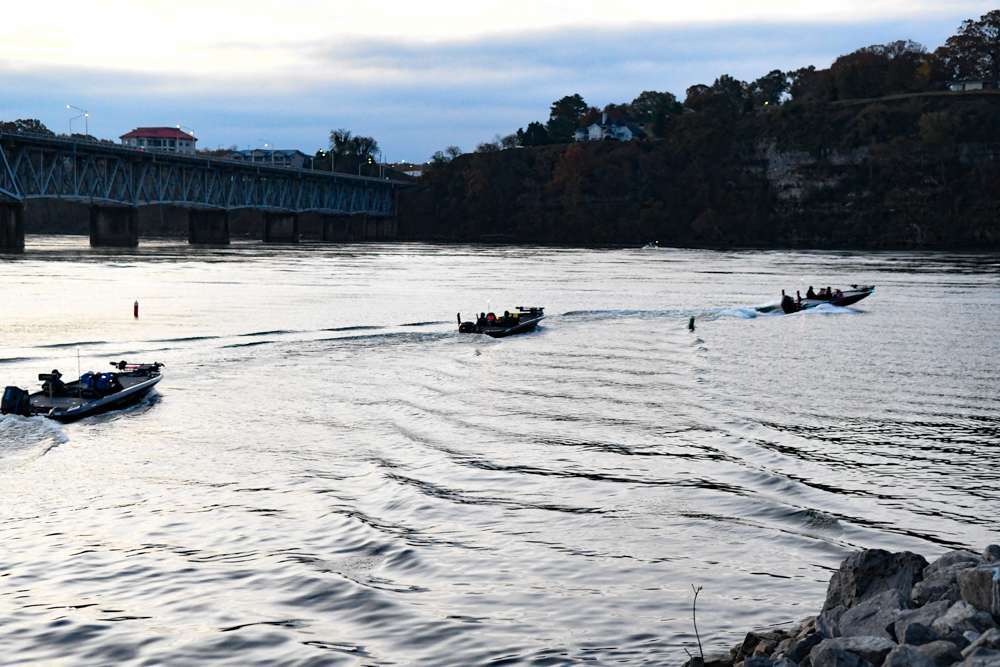
Justin Atkins, probably more than any of his peers, became excited when the Guaranteed Rate Bassmaster Elite at Pickwick Lake got moved from June to March. The Bassmaster Elite pro is from Florence, Ala., where the Tennessee River transitions from Wilson Lake into Pickwick.
“Pickwick is more magical than anywhere else on the Tennessee River system in March,” Atkins said. “You get the trifecta of bass opportunities with big largemouth, big smallmouth and big spotted bass.”
He continued, “The bass are healthier, weigh their heaviest and are easier to keep alive.”
If all the conditions line up, the winning weight could be among the heaviest of the season, should one key influencer favor the anglers. That influencer is current, more so on Pickwick than any other fishery in the Tennessee River system.
Here is Atkins’ analysis and breakdown of what to expect.
Lay of the lake
Pickwick has undeniably the best tailrace smallmouth bite of the Tennessee River fisheries. The reason? Current and an abundance of rocky habitat in the form of sheer bluff walls, large boulders formed by rock slides, chunk rock and pea gravel shorelines.
Look at a map of the immediate area below Wilson Dam and you will see a narrow channel, where that habitat is concentrated through the city of Florence. That is why countless tournaments are won there, but only when the current is at the magic speed. More on that to come.

As the river widens, other forms of prime habitat appear. Those are the signature ledges common on the chain as the river passes through Alabama and back into Tennessee. Farther down lake are large creeks that create ideal spawning migration routes for largemouth.
Add it all up, and you can find more legitimacy to Atkins’ lofty prediction about potential high winning weights.
All about the CFS
The current, at whatever speed and depth, will dictate every move made by the anglers during the tournament. That includes lure choices, fishing locations and how they will manage their time. All of that comes down to CFS, or the cubic feet per second of water that is discharged below Wilson Dam by the Tennessee Valley Authority.
CFS is ever changing in spring, due to heating demands of electric customers, and of course, the weather and rain patterns.
Smallmouth and largemouth bites are both in play when the CFS is at a magic number. Too much or too little current swings the momentum in opposite directions for both species.
“When you have too much it makes it difficult for the fish to set up on rocky current breaks,” said Atkins. “What that magic number is varies, and you have to feel it out in practice.”
Betting on the tailrace for the win is too risky, especially when weighed against the caliber of anglers competing. Smallmouth will be caught throughout the lake in an ideal scenario, according to Atkins.
“Smallmouth tournaments aren’t just won at the dam; they can be caught throughout the lake,” he said. “There are plenty of current breaks, rocky banks that can spread the field out.”
Atkins said an ideal number for game week is 150,000 CFS. At that rate he would begin the day fishing for smallmouth and then transition to largemouth. A mixed bag win could result should the tailrace not get taken out of the game.
Smallmouth breakdown
Smallmouth position tight to habitat under high-volume current. When that happens, precision casting to specific spots is a must. So is understanding how the smallmouth relate to that cover based on current flow.
“It might be something specific as the front or back side of a gravel bar, the inside or backside of a river bend,” said Atkins. “Or even the specific casting angle to an isolated rockpile.”
The attractants are current breaks providing ambush points for the smallmouth. Those fish are more responsive to current than largemouth, according to Atkins’ experience on Pickwick.
“You can get the largemouth to bite all day, but the smallmouth tend to have more defined feeding periods,” he said.
The chances of current being turned up are likely in March. Water color can change from clear to dingy, presenting another game changer for sight-feeding smallmouth.
“When that happens, smallmouth seek clearer water, which is often in the backs of pockets,” said Atkins. “That occurs a lot down lake, when the river takes on a heavy load of dirty water.”
Largemouth breakdown
A classic prespawn largemouth bite could be in play, should water temperatures reach the high 50s, adding to the potential for heavy, mixed-bag weights. Success will depend on the timing of the seasonal weather transitions between winter and spring.
“A lot of guys will like this scenario, as the largemouth will be wanting to move shallow, so there could be something for everyone,” said Atkins. “It’ll be typical prespawn with running an intercept-type pattern to find the fish as they migrate from the river channel into the creeks.”
Like smallmouth, fast current will pause the migration as the largemouth hold on breaklines and breaks. Depending on the weather and current, that could have largemouth biting anywhere from 20 feet to 2 feet.
“When you get just the right amount of current, the fish can be hard to locate, but the payoff is the potential to win, when you find them,” said Atkins. “To catch 90- to 100-pounds will take a lot of current, but you must know all of the nuances of how that influences each area.”
That means local knowledge could play big in the tournament.
“During practice, a guy might write off a good area if it doesn’t produce when he fishes there,” said Atkins. “Guys familiar with the timing of the spot will know to come back, hit it at just the right time.”
That will make time management critical, with the lake in play from end to end, and the mixed bag scenario key to advancing through the competition.
“There is more of a mixed bag setup than anywhere on the schedule,” said Atkins. “You can get into a scenario where the largemouth and smallmouth are both biting at different times of the day.”
On the positive side, those scenarios provide many more options and opportunities than if the tournament were held in June.
“Only the lower one-third of the lake would be in play, everyone would be piled up and the catches wouldn’t be as good,” said Atkins. “There are so many tournaments during June that the patterns are all well known and repetitive.”
For sure, there will be no community hole fishing during the tournament. Nothing but a wide-open game on one of Bassmaster Magazine’s Top 100 Bass Lakes.

